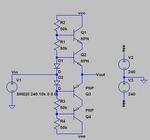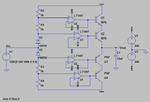Knillinux
Newbie level 2
Splitting voltage across BJTs to avoid breakdown
Hi,
I'm trying to use a BJT bipolar totem pole to drive a MOSFET gate to an arbitrary voltage, similar to this:

However, I am working with +/- 240 V, driving gate capacitances of over 10nF at ~1 MHz, which requires up to 4.5A and hundreds of watts of power in the BJTs. I'm finding it difficult to get power BJTs, especially PNPs, which have a 450+V CE breakdown voltage and can dissipate hundreds of watts of power.
So is it possible to split the voltage between chained BJTs? Here's a design I threw together to do this:

The resistor ladder splits the voltage evenly between the BJTs so that none of them experience a Vce over 240V. The diodes are to compensate for the Vbe of the BJTs.
It works well in SPICE, but I don't have time to do real life testing before inserting this into my project. The resistor values can be lowered if more current is needed to feed the BJTs.
Are there any potential problems I'm overlooking?
Hi,
I'm trying to use a BJT bipolar totem pole to drive a MOSFET gate to an arbitrary voltage, similar to this:

However, I am working with +/- 240 V, driving gate capacitances of over 10nF at ~1 MHz, which requires up to 4.5A and hundreds of watts of power in the BJTs. I'm finding it difficult to get power BJTs, especially PNPs, which have a 450+V CE breakdown voltage and can dissipate hundreds of watts of power.
So is it possible to split the voltage between chained BJTs? Here's a design I threw together to do this:

The resistor ladder splits the voltage evenly between the BJTs so that none of them experience a Vce over 240V. The diodes are to compensate for the Vbe of the BJTs.
It works well in SPICE, but I don't have time to do real life testing before inserting this into my project. The resistor values can be lowered if more current is needed to feed the BJTs.
Are there any potential problems I'm overlooking?

